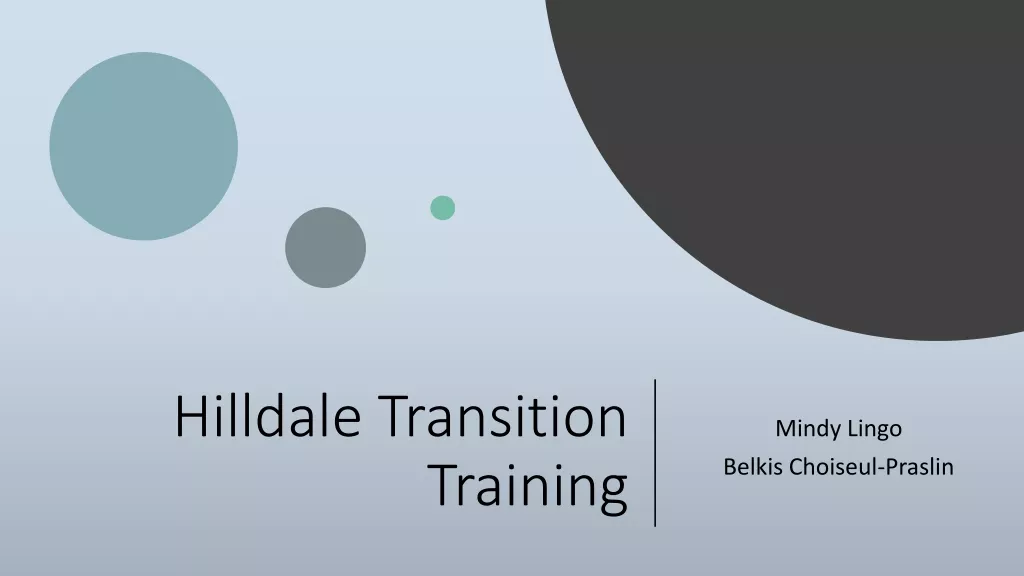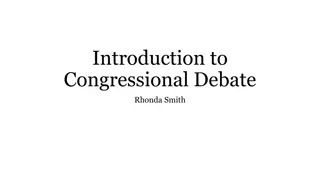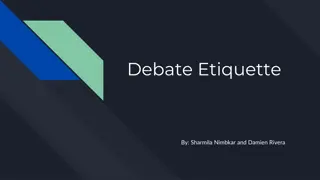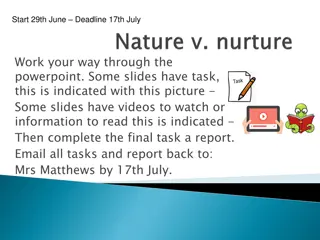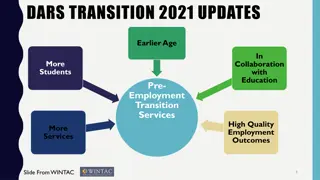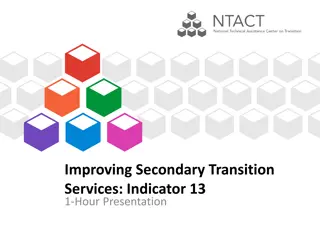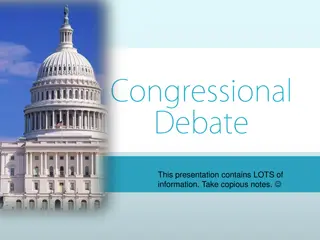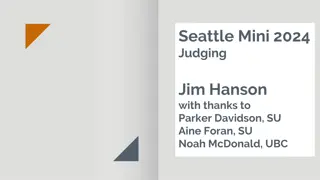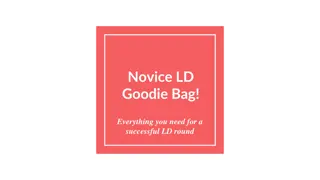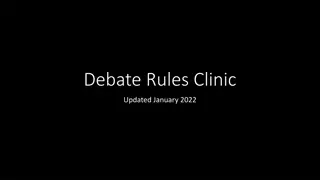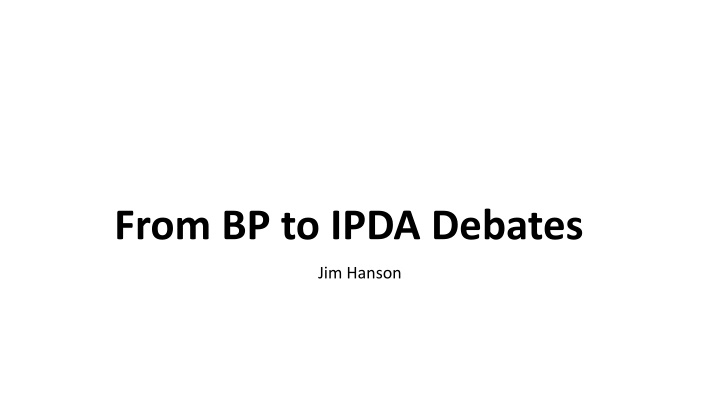
Mastering IPDA Debate Format for Competitive Success
Dive into the world of IPDA debates with a comprehensive guide covering team dynamics, engaging topics, striking tactics, and key aspects of IPDA format. Enhance your debate skills and learn how to craft compelling arguments to sway the judge in your favor.
Download Presentation

Please find below an Image/Link to download the presentation.
The content on the website is provided AS IS for your information and personal use only. It may not be sold, licensed, or shared on other websites without obtaining consent from the author. If you encounter any issues during the download, it is possible that the publisher has removed the file from their server.
You are allowed to download the files provided on this website for personal or commercial use, subject to the condition that they are used lawfully. All files are the property of their respective owners.
The content on the website is provided AS IS for your information and personal use only. It may not be sold, licensed, or shared on other websites without obtaining consent from the author.
E N D
Presentation Transcript
From BP to IPDA Debates Jim Hanson
Teams Teams You are on a two person team BUT if you wish you can be a one person team The debate has two teams against each other (NOT 4) Affirmative supports the topic Negative is against the affirmative/the topic Instead of ranking one team wins the debate by making a stronger case for or against the topic.
Topics Topics You will get 5 topics. They are usually on current issues, government policies, value comparisons, and tech/sports/fashion. Democrats will lose the house in the 2022 elections. The Covid vaccine should not be mandatory after the Covid pill is approved and available for use. Social Sciences overemphasize the science. The US should expand the use of nuclear power. The US should regulate Social Media algorithms.
Topic Striking Topic Striking The neg strikes the first topic they don t want (as in we don t want to debate the 4th topic ) The aff strikes the next topic they don t want The neg strikes the next topic they don t want The aff then chooses the topic from the remaining two topics Make sure someone, usually the judge, restates the topic you are debating.
The Goal of the Debate is . . . The Goal of the Debate is . . . To give the judge better reasons to vote for or against the topic than the other team Kind of like the strongest argument(s) initiated by a team used in BP debate.
Key Aspects of IPDA Part 1 Key Aspects of IPDA Part 1 Prep time is 20-30 minutes You can and should do research during prep time New Arguments mostly only in the first speeches Most of your speeches are spent refuting and rebuilding.
Key Aspects of IPDA Part 2 Key Aspects of IPDA Part 2 Cross-Examination instead of POIs (Cross-Exam is a set 2 minute period of questioning and answering) Each debater gives two speeches and does two cross- examinations Let s look at this in more detail . . .
Prep Time Prep Time After choosing the topic, debaters have 20-30 minutes to prep. You will be told the 1ac start time so you know the exact amount of prep time you have. During Prep: The debaters prep a case and responses to arguments they expect opponents will present Debaters can and should use the internet; using sources and statistics and studies in this kind of debate is common and encouraged Coaches and teammates can help debaters prepare It is like a totally open notes exam.
New Material in IPDA New Material in IPDA In the First Affirmative make your case for the topic For the rest of the debate, the affirmative defends that case In a few cases, the second affirmative can add an argument for the topic but USUALLY DOES NOT In the First Negative make your case against the aff case/the topic (AND refute the first affirmative) For the rest of the debate, the negative defends the negative case In a few cases, the second negative can add an argument against the topic but USUALLY DOES NOT.
Reminder on what is in a good case! Reminder on what is in a good case! You show the topic causes/increases/reduces specific benefits or harms Topic: The US should increase the use of solar power BAD Meh throw it out: Power is good BAD Meh throw it out: Solar power is used in some areas and sometimes people might not get fully charged so they turn to other kinds of energy . . . Blah blah blah BAD!
Reminder on what is in a good case! Reminder on what is in a good case! GOOD: Solar Power will reduce climate change reducing famine, forest fires, hurricanes. GOOD: Solar Power depletes precious metals causing environmental damage AFF: Things are bad, The topic makes it better, Here s the impact to that NEG : Things are okay, The topic makes it worse, Here s the impact to that.
Refutation and Rebuilding Refutation and Rebuilding After the first speeches . . . Debaters should respond to their opponent and rebuild the case in the first speech You can add ideas/thoughts to the case but the more you restate, explain the importance of your original case the better You also rebuild your responses to your opponent s case as the debate continues.
Question and Answer: Cross Question and Answer: Cross- -Examination Examination There are no POIs in IPDA. Instead, you have 2 minute cross-examinations after the first four speeches where debaters ask questions uninterrupted. Lines of questioning are usually ideal (ask a question get an answer, ask a question about the answer); For example: Questioner: what is going to solve that Respondent: x will solve Question: okay, what is it about x that really would solve the problem?
Team IPDA Times in the Debates . . . Team IPDA Times in the Debates . . . 4 min 1AC (present aff case), 2 min cx 5 min 1NC (present neg case, respond to aff case), 2 min cx 5 min 2AC (respond to neg case, defend aff case), 2 min cx 4 min 2NC (defend responses/case), 2 min cx 3 min 1NR (defend responses/case that 2NC did not address) --NOTE if a team is just one person, that person gets 1 min prep before the above speeches. 4 min 1AR (defend responses/case) (1 min prep before) 4 min 2NR (show won responses/case) (1 min prep before) 3 min 2AR (show won responses/case) (1 min prep before).
After the last speech in the debate . . . After the last speech in the debate . . .
DEBATE ENDS DEBATE ENDS The judge will send The judge will send an email ballot an email ballot Who won and speaker points IPDA Points Scale is 24.1 to 29.9 E.g. 27.3 28.4 29.7 After that the judge will talk with you.
AND NOW A HALF TIME TEAM IPDA DEBATE AND NOW A HALF TIME TEAM IPDA DEBATE Teams are . . . Topic Strikes will be on these topics . . . The US should expand the use of nuclear power. Democrats will hold the Senate in the 2024 elections. Fashion magazines are, on balance, harmful. The U.S. should forgive most student loan debt. The US should regulate Social Media algorithms.
Half Time Team IPDA Debate Times . . . Half Time Team IPDA Debate Times . . . 12 minute Prep 2 min 1AC (present aff case), 1 min cx 2.5 min 1NC (present neg case, respond to aff case), 1 min cx 2.5 min 2AC (respond to neg case, defend aff case), 1 min cx 2 min 2NC (defend responses/case), 1 min cx.
Half Time Team IPDA Debate Times . . . Half Time Team IPDA Debate Times . . . 1.5 min 1NR (defend responses/case that 2NC did not address) --NOTE if a team is just one person, that person gets 1 min prep before the above speeches. 2 min 1AR (defend responses/case) (1 min prep before) 2 min 2NR (show won responses/case) (1 min prep before) 1.5 min 2AR (show won responses/case) (1 min prep before).
Example IPDA Debates Example team debate: https://www.youtube.com/watch?v=5lL3b4mo-Vg&t=1393s Example one on one debate: https://www.youtube.com/watch?v=WrNEJmS0x7M&t=7s

